

The “classical theory” that fat is deposited in the adipose tissue [body fat] only when given in excess of the caloric requirement is finally disproved.
—Ernst Wertheimer, in Physiological Reviews74
The final myth complicating our lives and destroying our health is the idea that calories are the most important consideration in our food choices, so we can eat anything we’d like as long as we’re careful to analyze food labels for serving sizes and calories. So here is our third Calorie Myth:
Calorie Myth #3: All Foods Are Fine in Moderation
Most diets suggest that we can eat whatever we want and be fine as long as we monitor our portion sizes and don’t eat too many calories. But as we’ve discussed, calories are not all that matter. What comes along with calories can disrupt our fundamental biology for generations. So why do we hear so much about calories and eating “everything” in moderation? One reason is that many of the institutions perpetuating this myth are funded by companies that produce processed foods. These institutions can keep their corporate benefactors happy and appear reasonable by preaching a message of moderation. (The “foods” aren’t bad—your willpower is! It’s your “personal responsibility” to resist them!) Now anyone can sell anything and everyone is happy—except for the consumers whose biology is being broken.
WHY HORMONES MATTER MORE THAN MODERATION
When we are told to focus on calories and moderation instead of food and biology, “healthy” quickly becomes a highly relative term. For example, a popular fast food chain celebrates the health benefits of its offerings that contain less than 400 calories. Never mind the high-fructose corn syrup, refined flour, trans fats, and pink slime in these edible products we collectively refer to as “food,” they’re low calorie and therefore “smart” choices.
We know this is absurd. We know that the nutritional and hormonal impact of calories matters immensely. But we can see why the calorie craze is perpetuated. Want to sell anything and call it healthy? Convince people calories are all that matter. Then mix together the cheapest and most shelf-stable ingredients you can find and call it edible. Finally, shrink the serving size until you can call it low calorie and therefore “healthy.” One-hundred-calorie snack packs for everyone!
Misguided recommendations around moderation are not new. Just a few decades ago we were given a message of smoking in moderation, but then the science linking smoking to addiction and disease became clear. The link between inSANE foods addiction and disease is now clear. As Yale University’s Kelly Brownell puts it, “By 1964, there was sufficient scientific evidence . . . [but] many years passed and many millions died before decisive action was taken to [turn the tide against smoking]. . . . Repeating this history with food and obesity would be tragic.”75
Will a single soda or candy bar every once in a while kill us? Of course not. But neither will a single cigarette every once in a while. The question is what we should be recommending. The message of moderation and calories is rooted in money, not science. Accurate recommendation would revolve around food quality and hormones, not calorie count and moderation.
THE SIMPLE SCIENCE OF HORMONES
At the risk of being a little gruesome (I’d suggest putting down your fork if you’re reading this book while eating a SANE meal), let’s look at one way scientists discovered the important relationship between hormones and health: through a procedure known as parabiosis. Parabiosis occurs when researchers cut two live animals open and then join them so they share the same blood supply and hormones. In other words, researchers create conjoined twins.
BEFORE PARABIOSIS |
AFTER PARABIOSIS |
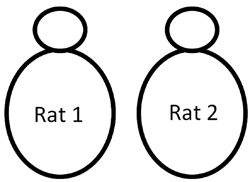 |
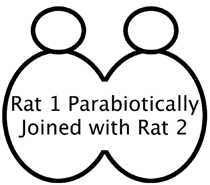 |
Why would researchers create a Franken-rat with one set of hormones but twice as much of everything else? Because it allows them to investigate the impact of hormones on human health. For example, when researchers join an obese rat to a lean rat, the lean rat gets leaner regardless of the quantity of calories it eats. How is that possible? Think back to how the set-point works.76
The obese rat is producing a massive amount of body-fat-burning hormones in an effort to get itself back to a normal level of body fat. But because the obese rat is clogged and cannot respond to the body-fat-burning hormones effectively, it stays heavy. However, the lean rat is not clogged. The lean and clog-free rat is able to respond to all those body-fat-burning hormones.
Lots of body-fat-burning hormones + the ability to respond to them = burning body fat despite eating the same quantity of calories.
Similarly, when researchers stitch a normal rat and a starved rat together, the starved rat’s body-fat-storing hormones make the normal rat get fatter without eating any more calories. The starved rat is producing body-fat-storing hormones in an effort to get back to its set-point. These body-fat-storing hormones enter the normal rat, and it does exactly what the hormones tell it to do: the normal rat stores body fat without eating any more or exercising any less.
Besides the horror of joining living animals together, these studies powerfully demonstrate how any message regarding eating or exercise that doesn’t involve hormones is at best incomplete. And that is only the tip of the investigative iceberg.
Researchers at the Veterans Affairs Palo Alto Health Care System genetically altered mice so they would no longer have a primary enzyme responsible for storing body fat (hormone-sensitive lipase). These mice ate more and gained 70 percent less than normal mice. In the researchers’ words, completely independently of calories, altering mice’s hormones caused “a drastic reduction in lipogenesis [body fat creation].”77
Researchers at the University of Basel genetically altered mice’s hormone levels so that the mice stayed lean, “in spite of reduced physical activity,” and were “unaffected [by] caloric intake.”78
Peter Havel from the University of California tells us that “mice which are unable to produce ASP [a hormone involved in the formation of body fat] consume 30 percent more food than wild-type mice, yet have reduced adipose [body fat] mass and are resistant to weight gain.”79
These and hundreds of other experiments show that hormones are the key to our set-point and therefore long-term weight gain or loss. The journal Neuroscience & Biobehavioral Reviews captures the importance of healing our hormones before we are permanently free of body fat: “humans that become obese gain weight because they are no longer able to lose weight.”80 We gain weight because our metabolic system is hormonally broken. Starving a broken system will never fix it; there’s a good chance it will make it worse. We fix the problem by understanding and healing our hormones.
HOW HORMONES INFLUENCE OUR SET-POINT
Our digestive system, muscle tissue, and fat tissue are constantly communicating with our nervous system and brain via hormones. They are talking about how much fuel they think we need to keep us at our set-point. If they think we are at risk of rising above our set-point, they automatically decrease our calories in and increase our calories out, and vice versa.
When we eat SANE high-quality calories, this conversation goes well. Higher-quality calories trigger body-fat-burning hormones. The right amount of hormones are used and the right message is communicated: “Burn body fat.”
However, when we eat inSANE low-quality calories, communication breaks down. Our body doesn’t have a good idea of how much fuel we need, hormones become “dysregulated,”81 and our body demands more food, since it does not know what is going on and errs on the side of not starving. Thanks to this communication breakdown, we overeat, become hormonally clogged, and gain weight. You can count calories all day and will not set yourself up for long-term fat loss if you are eating low-quality calories that trigger excess body-fat-storing hormones such as insulin.
Known in scientific circles as the most important hormonal factor influencing body fat creation, insulin is activated only when we need to get fuel into our cells. Our body “hears” insulin in the bloodstream “communicating” that we have energy on its way to our cells and therefore do not need to use any stored energy—i.e., burn body fat. So the hormone insulin—not the calories we ate—blocks the burning of body fat.
Calories from inSANE starch and sweets trigger the release of ridiculous amounts of insulin. All that insulin gets those calories into our cells, but then we still have insulin left over in our bloodstream. That excess insulin clogs us up and removes our ability to burn body fat no matter how much time we spend on the treadmill.
Things go from bad to worse if we keep this up for too long. Not only does all the excess insulin destroy our ability to burn body fat, it also makes our body resistant to insulin (meaning that our pancreas has to produce more insulin to do the same job). To quickly understand how this works, think about this analogy: becoming resistant to the effects of insulin is like becoming resistant to the effects of alcohol. When people drink alcohol in moderation, everything is fine. It takes relatively little alcohol to generate the desired effect, so people don’t drink too much of it. However, if people drink too much alcohol, they become resistant to alcohol’s effects and then they have to drink more to get a buzz. This volume of alcohol eventually destroys their liver and makes them sick.
Similarly, when people eat mostly SANE foods, everything is fine. It takes just a little insulin to get energy into cells, so the body doesn’t produce too much of it. If our insulin levels remain low, we don’t gain weight—even when we eat large amounts of food. Instead of being stored as fat, extra blood-sugar-increasing calories are burned off or eventually exit the body as waste. But if people eat a significant amount of starch and sweets, their bodies become resistant to insulin’s effects. Then their bodies have to produce more insulin to get energy into cells. This volume of insulin eventually destroys their pancreas and makes them sick. Insulin resistance is becoming an epidemic in our country. At least one in four Americans is insulin resistant. All this excess insulin forms the backbone of our clog and causes our set-point to creep up. It also increases the rate at which we store body fat because excess insulin preferentially puts calories into our fat tissue. No matter how resistant other tissues become to insulin, our fat tissue is always receptive. While that is technically good because it keeps insulin resistance from killing us (it prevents toxically high levels of blood sugar), it can prevent us from losing weight. We end up with more body fat and no ability to burn it.
WHERE THE AVERAGE AMERICAN GETS CALORIES
Insulin-spiking starch and sweeteners make up 43 percent of what we eat.
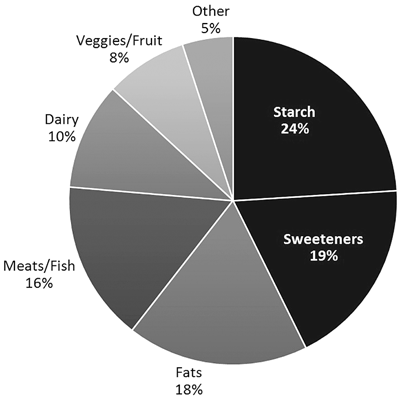
Once most of the calories we eat are being stored in fat cells because insulin cannot get them into other cells, internal starvation has set in. We eat plenty of food but starve on the inside because insulin cannot effectively get that energy into any cells other than our fat cells. With excess insulin shuttling most calories into fat tissue and eliminating our ability to burn body fat, the body has no choice but to slow down, burn muscle tissue, and demand more food.
THE ACTUAL CAUSE OF OBESITY
Meet Terri. She is internally starving and needs 500 calories of energy. Terri is also a yo-yo dieter and has already slowed down her metabolism and burned as much muscle as she can. Needing some calories, Terri eats 500 calories. Instead of those 500 calories getting into the organs needing it, only 250 make it in while the other 250 are ignored—thanks to insulin resistance—and stored as new body fat. Terri still needs 250 calories. She cannot slow down anymore. She cannot burn any more muscle. And thanks to all the excess insulin floating around, she does not have the ability to burn body fat. What is her only option? Overeat. Eat 250 extra calories. So Terri snacks on 250 extra calories to keep her cells from starving. But now only some of the 250 calories make it to the cells needing them while the rest are stored as body fat. Again, she must overeat even more. This process of overeating to keep a clogged body fueled repeats itself until Terri eats 1,000 calories to meet her need for 500 calories. Terri’s body is leaking calories into her fat cells and has to compensate by taking in extra calories. Continue this “overeat to compensate for the clog” cycle day after day and Terri gains body fat. On the surface it seems that she is gaining body fat because she is eating too many calories. But Terri’s high consumption of calories is not the cause of her weight gain. It is a symptom of the hormonal clog caused by inSANE low-quality calories.
Obesity is not caused by eating too many calories and it is not cured by eating fewer calories. Overeating is not the cause of obesity, says Hilde Bruch at Baylor University. “It is a symptom of an underlying disturbance. . . . The changes in weight regulation and fat storage are the essential disturbances.”82
Problems are not solved by treating symptoms. That is why the Calorie Myths fail more than 95 percent of the time. Basing your diet on calorie count is like taking a medication that treats the symptoms of an illness, but doesn’t cure the underlying cause. We can monitor our bodies all we want by tracking calories in versus calories out, but if we’re not eating foods that fuel our biological processes and help to regulate our hormones, we’re not curing our bodies.
INCORRECT |
CORRECT |
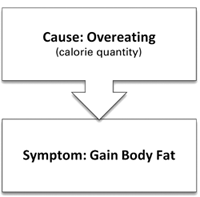 |
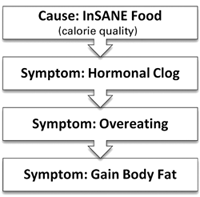 |
Now that we’ve walked through each of the Calorie Myths, I want to spend a little time talking about how these myths were created in the first place. Why haven’t you heard about this science until now? Sadly, financial motivation is part of the answer. More money can be made off sick, overweight, and unhappy people than off healthy, fit, and happy people. The bigger we are, the bigger the profits of the $3.1 trillion food, $150 billion fitness, and $500 billion pharmaceutical industries.
Big food, big fitness, and big pharma want us to stay slim the way big tobacco wants us to stop smoking. You can’t believe everything you hear. Especially if it is coming from a person or organization whose profits depend on your continued weight and health struggles. As SUNY professor Jeffrey M. Friedman explains, “Why has the scientific evidence from long-standing obesity research not found its way into the minds of the public . . . ? Perhaps it is because these views are shaped by a constant barrage of advertisements from the diet industry which has a multi-billion dollar interest in promoting the view that weight can be controlled through volition [willpower] alone.”83
Type 2 Diabetes: Protect Yourself and Your Children
Type 2 diabetes is like running water into a hormonally clogged sink for so long that water overflows all over the place and the faucet breaks down. Once so much insulin is produced that it is overflowing in our bloodstream and our ability to produce insulin has broken down, we develop type 2 diabetes.